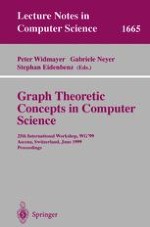1999 | Buch
Graph-Theoretic Concepts in Computer Science
25th International Workshop, WG’99 Ascona, Switzerland, June 17–19, 1999 Proceedings
herausgegeben von: Peter Widmayer, Gabriele Neyer, Stephan Eidenbenz
Verlag: Springer Berlin Heidelberg
Buchreihe : Lecture Notes in Computer Science
Enthalten in: Professional Book Archive
